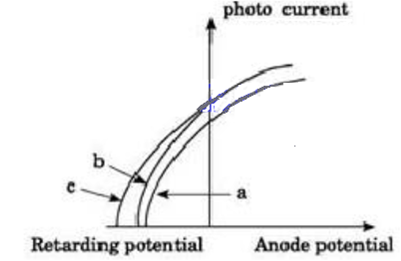 Multiple Choice Questions
Multiple Choice QuestionsOut of the following which one is not a possible energy for a photon to be emitted by hydrogen atom according to Bohr's atomic model?
1.9 eV
11.1 eV
13.6 eV
13.6 eV
A source S1 is producing, 1015 photons of wavelength 500 A. Another source S2 is producing 1.02 x 1015 photons per second of wavelength 5100 A. Then, power of S2) (power of S1) is equal to
1.00
1.02
1.04 A
1.04 A
When monochromatic radiation of intensity I falls on a metal surface, the number of photoelectrons and their maximum kinetic energy and N and T respectively. If the intensity of radiation is 2I, the number of emitted electrons and their maximum kinetic energy are respectively
N and 2T
2N and T
2N and 2T
2N and 2T
The mean free path of electrons in a metal is 4 x 10-8 m. The electric field which can give on an average 2 eV energy to an electron in the metal will be in unit of V m-1
8 x 107
5 x 10-11
8 x 10-11
8 x 10-11
The number of photoelectrons emitted from light of a frequency v (higher than the threshold frequency vo) is proportional to
v-vo
threshold frequency (vo)
the intensity of light
the intensity of light
Monochromatic light of wavelength 667 nm is produced by a helium-neon laser. The power emitted is 9 mW. The number of photons arriving per second on the average at a target irradiated by this beam is
9 x 1017
3 x 1016
9 x 1015
9 x 1015
The figure shows a plot of photocurrent versus anode potential for a photosensitive surface for three different radiations. Which one of the following is a correct statement?
Curves a and b represent incident radiations of different frequencies and different intesities
Curves a and b represent incident radiations of same frequency but of different intesities
Curves b and c represent incident radiations of different frequencies and different intensities
Curves b and c represent incident radiations of different frequencies and different intensities
The work function of a surface of a photosensitive material is 6.2 eV. The wavelength of the incident radiation for which the stopping potential is 5 V lies in the
ultraviolet region
visible region
infrared region
infrared region
The ground state energy of hydrogen atom is -13.6 eV. When its electron is in the first excited state, its excitation energy is
3.4 eV
6.8 eV
10.2 eV
zero
A particle of mass 1 mg has the same wavelength as an electron moving with a velocity of 3 x 106 ms-1. The velocity of the particle is.
(mass of electron = 9.1 x 10-31 kg)
2.7 x 10-18 ms-1
9 x 10-2 ms-1
3 x 10-31 ms-1
3 x 10-31 ms-1
